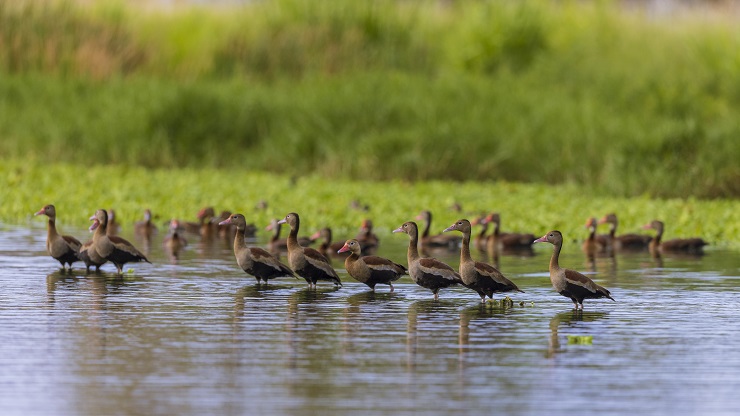
It is undoubtedly the most wonderful time of year – when we don our binoculars and boots and head off on a tradition spanning more than a hundred years – that of the Christmas Bird Count! I’ve been leading a small but faithful group on Trinidad for several years to count birds within a livestock farm that is generally restricted to the public (you can read about some of those shenanigans here); this was the first time I was to embark on a CBC on the smaller island of Tobago. What made this all the more appealing (on a selfish level) was that I was not the group leader – and so was relieved of much responsibility!
When I was invited to participate by a fellow birder and friend, I was admittedly a bit intrigued by its designation of being the “THA Christmas Bird Count” – the first three letters representing the Tobago House of Assembly, the local administrative governing body on Tobago. On Trinidad, there was no such state involvement in the count, we were pretty much on our own. I didn’t have much of an idea of what I was getting myself into – but I was pleasantly surprised.
As I arrived at the meeting spot half hour before sunrise, I noticed quite a number of people milling around a white van with the THA logo emblazoned on the side. To my surprise – there was breakfast! I felt unprepared for this level of pampering. A box was already set aside for me. I had packed my customary bowl of oatmeal; so I dealt with that before it turned to stone (please tell me this has happened to someone else out there). Anyway, I digress. We soon departed to our various locations, bellies full and eyes hungry for birds.
Our group of six intrepid souls began at one of my favourite locations on the island – sewage ponds. Also termed in much more palatable fashion as “treatment ponds”. A calling Black-faced Grassquit was the first bird on the list, quickly followed by the much more melodious House Wren. A trio of Carib Grackles flew overhead, and a pair of Grey Kingbirds surveyed their territory from up high. A Green Heron stalked the canals, and a couple Eared Doves flushed as we walked past. To access the ponds themselves, we passed through a stand of vegetation that yielded White-fringed Antwren and Scrub (Tobago) Greenlet.
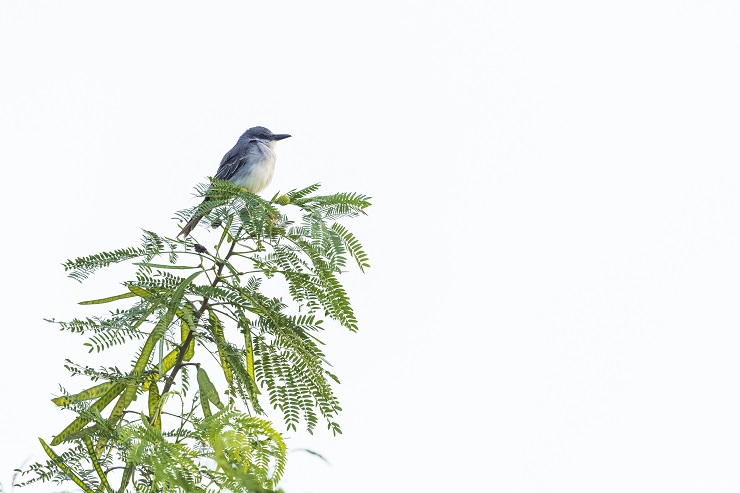
Grey Kingbird
As the ponds came into view, a Great Egret took flight, and several Black-crowned Night-Herons stood hunched over the water, unwilling to break their own silhouette in the event it would jeopardize their chances at snagging a final meal before daylight took hold. More than a few Anhingas were perched in the surrounding trees. Paddling around in the water were many Least Grebes along with Common Gallinules and the bird of the day – Lesser Scaup. Three of them in fact, rare visitors from the north. The usual ducks were also present – Black-bellied Whistling Duck and White-cheeked Pintail. Both of these are dabbling ducks while the scaups are divers. There was not much time to relish any sighting, however, as many other locations beckoned.
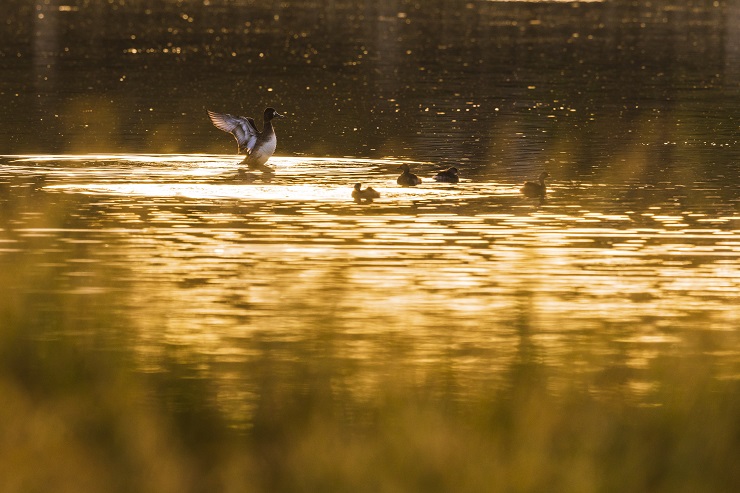
A Lesser Scaup flaps its wings in front of attending Least Grebes.
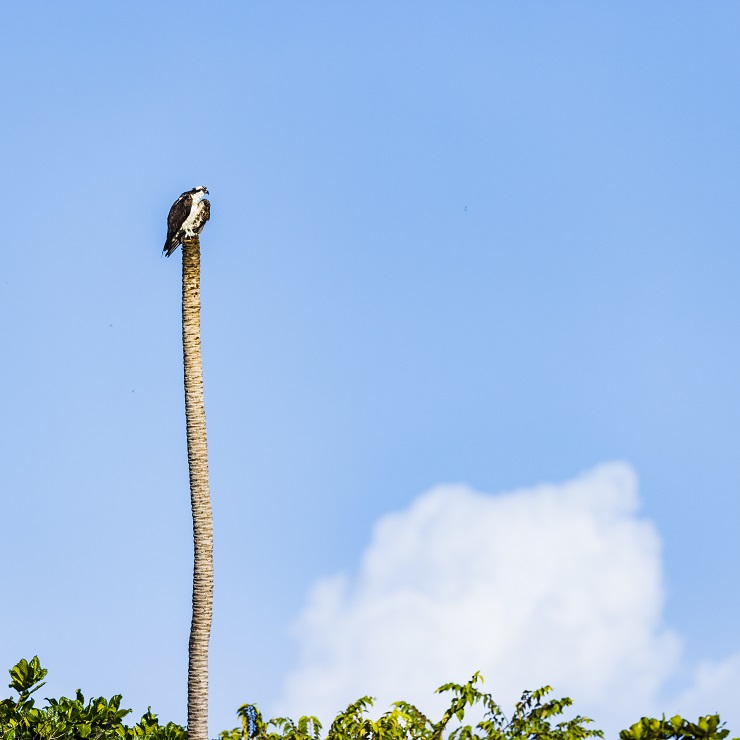
The Osprey in a quintessential tropical setting.
On the way out we saw a few Lesser Yellowlegs along with a Greater Yellowlegs. White-winged Swallow was also added to the list. At an adjacent wetland we saw an Osprey perched on an old coconut tree stump, several Smooth-billed Ani as well as a local specialty Mangrove Cuckoo. The latter was gently coerced with audio playback – a practice I explained to the other participants that is not typically condoned for trivial purposes of simply seeing a bird; the exception was made in this case as the goal was to record the presence of the bird for this official CBC. The call was played for a short while and then turned off. After less than five minutes, we heard a response from deep within the mangrove. Some zealous folks suggested playing the call again, excited with the prospect of seeing such a beautiful bird. Patience being the key, we waited silently – and sure enough we were able to eventually get a view before it continued its journey.
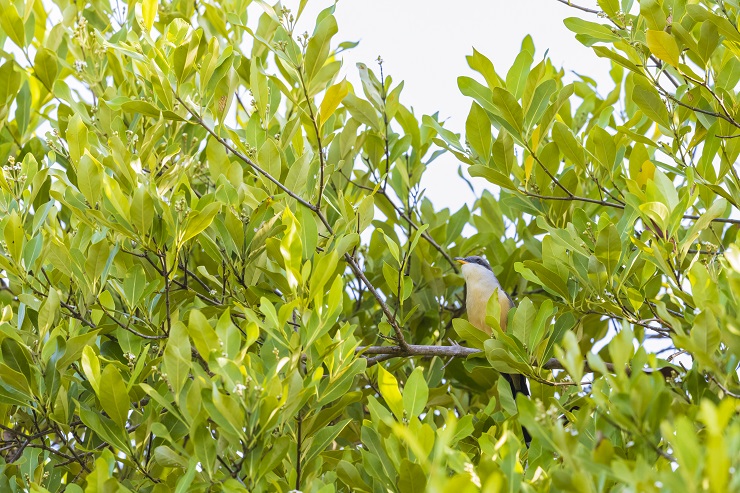
Mangrove Cuckoo
Checking some of the other ponds revealed more ducks, namely a group of ten Blue-winged Teal and a staggering number of Black-bellied Whistling Ducks. A large, bulky falcon cruising overhead could only be a Peregrine Falcon. As soon as we noticed it, a Merlin appeared from nowhere and headed directly for the Peregrine, divebombing the larger falcon. That was the first time I ever saw any interaction between these two high octane migratory predators. As per usual falcon procedure, it all happened much too quickly for me to get a decent photograph!
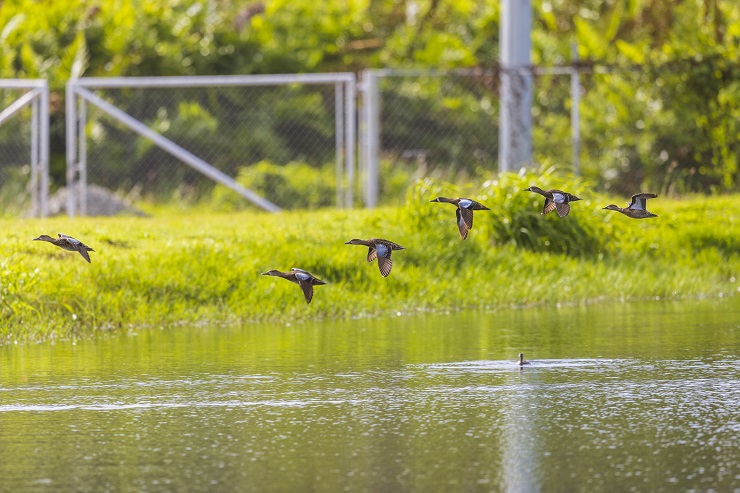
Blue-winged Teal

Meticulous counting led us to a total of 122 Black-bellied Whistling Ducks.
The next stop was along the coast, here we added Royal Tern, Laughing Gull, Sanderling, and a whopping number of Ruddy Turnstones to the list. By this time the sun was already stinging any exposed skin, as idyllic as the location was the white sand and azure water only served as reflectors, adding to the sensation of being mildly cooked as we counted birds.
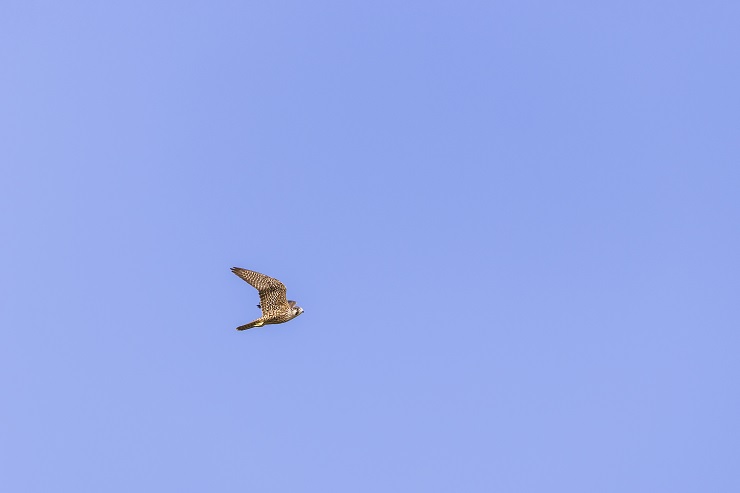
The Peregrine Falcon after its fleeting interaction with the Merlin.
Skirting around the international airport to the mangroves on its eastern end, we picked up Brown-crested Flycatcher and even more Barred Antshrikes. A pair of Yellow Warblers hunted insects in the canopy, and a Northern Waterthrush did the same just over the surface of the water. A Spectacled Thrush foraged among the leaf litter. This endearing and very familiar species grabbed the attention of all present, including the official event photographer from the THA! And yes, there was an official photographer sent to document us documenting birds – see the post here.
Our final stop was at another series of ponds bordering a lagoon on the southern coast of the island. Many Southern Lapwings and Purple Gallinules were added to the list, along with a lone immature Yellow-crowned Night-Heron. Thoroughly baked by this point, we returned to the start location where we were treated to a cold fruit juice and a delicious lunch.
Personally, I had never before been fêted like this for counting birds, but it certainly is something I can get used to. Our little group managed a final tally of 56 species! See the full list below:
Black-bellied Whistling-Duck (Dendrocygna autumnalis)
White-cheeked Pintail (Anas bahamensis)
Lesser Scaup (Aythya affinis)
Rufous-vented Chachalaca (Ortalis ruficauda)
Least Grebe (Tachybaptus dominicus)
Pale-vented Pigeon (Patagioenas cayennensis)
Ruddy Ground Dove (Columbina talpacoti)
White-tipped Dove (Leptotila verreauxi)
Eared Dove (Zenaida auriculata)
Smooth-billed Ani (Crotophaga ani)
Mangrove Cuckoo (Coccyzus minor)
Short-tailed Swift (Chaetura brachyura)
Copper-rumped Hummingbird (Saucerottia tobaci)
Wattled Jacana (Jacana jacana)
Common Gallinule (Gallinula galeata)
Purple Gallinule (Porphyrio martinica)
Southern Lapwing (Vanellus chilensis)
Whimbrel (Numenius phaeopus)
Ruddy Turnstone (Arenaria interpres)
Sanderling (Calidris alba)
Spotted Sandpiper (Actitis macularius)
Solitary Sandpiper (Tringa solitaria)
Greater Yellowlegs (Tringa melanoleuca)
Willet (Tringa semipalmata)
Lesser Yellowlegs (Tringa flavipes)
Laughing Gull (Leucophaeus atricilla)
Royal Tern (Thalasseus maximus)
Magnificent Frigatebird (Fregata magnificens)
Anhinga (Anhinga anhinga)
Brown Pelican (Pelecanus occidentalis)
Great Blue Heron (Ardea herodias)
Great Egret (Ardea alba)
Snowy Egret (Egretta thula)
Little Blue Heron (Egretta caerulea)
Tricolored Heron (Egretta tricolor)
Cattle Egret (Bubulcus ibis)
Green Heron (Butorides virescens)
Black-crowned Night-Heron (Nycticorax nycticorax)
Yellow-crowned Night-Heron (Nyctanassa violacea)
Osprey (Pandion haliaetus)
Belted Kingfisher (Megaceryle alcyon)
Red-crowned Woodpecker (Melanerpes rubricapillus)
Yellow-headed Caracara (Daptrius chimachima)
Merlin (Falco columbarius)
Peregrine Falcon (Falco peregrinus)
Green-rumped Parrotlet (Forpus passerinus)
Barred Antshrike (Thamnophilus doliatus)
White-fringed Antwren (Formicivora grisea)
Cocoa Woodcreeper (Xiphorhynchus susurrans)
Ochre-lored Flycatcher (Tolmomyias flaviventris)
Yellow-bellied Elaenia (Elaenia flavogaster)
Brown-crested Flycatcher (Myiarchus tyrannulus)
Tropical Kingbird (Tyrannus melancholicus)
Gray Kingbird (Tyrannus dominicensis)
Scrub Greenlet (Tobago) (Hylophilus flavipes insularis)
White-winged Swallow (Tachycineta albiventer)
House Wren (Troglodytes aedon)
Tropical Mockingbird (Mimus gilvus)
Spectacled Thrush (Turdus nudigenis)
Shiny Cowbird (Molothrus bonariensis)
Carib Grackle (Quiscalus lugubris)
Northern Waterthrush (Parkesia noveboracensis)
Yellow Warbler (Setophaga petechia)
White-lined Tanager (Tachyphonus rufus)
Blue-gray Tanager (Thraupis episcopus)
Palm Tanager (Thraupis palmarum)
Blue-black Grassquit (Volatinia jacarina)
Bananaquit (Coereba flaveola)
Black-faced Grassquit (Melanospiza bicolor)













Congrats on both a successful CBC and receiving the royal treatment you’ve long deserved. Just don’t get used to it!
Ha! Thanks, Mike!